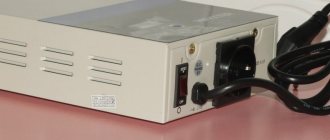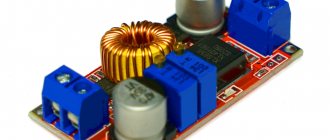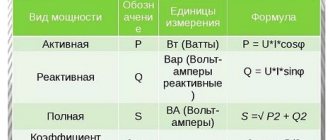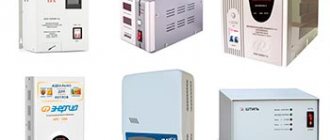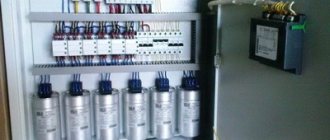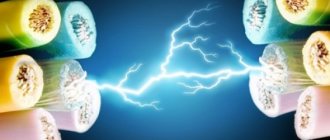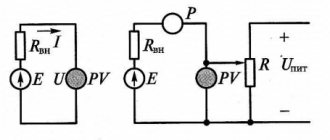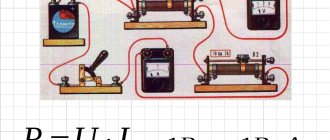Push-pull UPS
style=”display:inline-block;width:728px;height:90px” data-ad-client=”ca-pub-5076466341839286″
data-ad-slot=”2660907582″>
♥ Push-pull secondary power supplies are most widespread, although they have a more complex electrical circuit compared to single-cycle ones. They allow you to obtain significantly higher output power with high efficiency.
Circuits of push-pull converter-inverters have three types of connection of key transistors and the primary winding of the output transformer: half-bridge, bridge and with a primary winding tapped from the middle.
♥ Half-bridge circuit for constructing a key cascade. Its feature is the inclusion of the primary winding of the output transformer at the midpoint of the capacitive divider C1 - C2.
♥ The amplitude of the voltage pulses at the emitter-collector transistor transitions T1 and T2 does not exceed Upit the value of the supply voltage. This allows the use of transistors with a maximum voltage Uek up to 400 volts.
At the same time, the voltage on the primary winding of transformer T2 does not exceed the value of Upit/2, because it is removed from the divider C1 - C2 (Upit/2). The control voltage of the opposite polarity is supplied to the bases of key transistors T1 and T2 through transformer Tr1.
♥ In the bridge converter, the capacitive divider (C1 and C2) is replaced by transistors T3 and T4. Transistors in each half-cycle open in pairs diagonally (T1, T4) and (T2, T3).
The voltage at the transitions Uec of closed transistors does not exceed the supply voltage Upit. But the voltage on the primary winding of transformer Tr3 will increase and will be equal to the value of Upit, which increases the efficiency of the converter. The current through the primary winding of transformer Tr3 at the same power, compared to a half-bridge circuit, will be less. Due to the difficulty in setting up the control circuits of transistors T1 - T4, a bridge switching circuit is rarely used.
♥ An inverter circuit with a so-called push-pull output is most preferable in high-power inverter converters. A distinctive feature in this circuit is that the primary winding of the output transformer Tr2 has a terminal from the middle. For each half-cycle of the voltage, one transistor and one half-winding of the transformer alternately operate. ♥ This circuit is characterized by the highest efficiency, low ripple level and low noise emission.
This is achieved by reducing the current in the primary winding and reducing the power dissipation in the key transistors. The pulse voltage amplitude in half of the primary winding Tr2 increases to the value Upit, and the voltage Uek on each transistor reaches the value 2 Upit (self-induction emf + Upit). It is necessary to use transistors with a high value of Ukemax equal to 600 - 700 volts.
The average current through each transistor is equal to half the current consumption from the supply network.
Current or voltage feedback.
♥ A feature of push-pull self-excited circuits is the presence of feedback (Feedback) from the output to the input, in terms of current or voltage.
♥ In the current feedback , the coupling winding w3 of transformer Tr1 is connected in series with the primary winding w1 of output transformer Tr2. The greater the load at the inverter output, the greater the current in the primary winding of Tr2, the greater the feedback and the greater the base current of transistors T1 and T2. If the load is less than the minimum allowable, the feedback current in the w3 winding of transformer Tr1 is insufficient to control the transistors and generate an alternating voltage breaks down.
In other words, when the load is lost, the generator does not work.
♥ In the voltage feedback , the feedback winding w3 of transformer Tr2 is connected through a resistor R to the coupling winding w3 of transformer Tr1. This circuit provides feedback from the output transformer to the input of the control transformer Tr1 and then to the base circuits of transistors T1 and T2. ♥ Voltage feedback weakly depends on the load.
If there is a very large load at the output (short circuit), the voltage on winding w3 of transformer Tr2 decreases and a moment may come when the voltage on the base windings w1 and w2 of transformer Tr1 will not be enough to control the transistors. The generator will stop working. Under certain circumstances, this phenomenon can be used as protection against output short circuit.
♥ In practice, both circuits with feedback feedback in both current and voltage are widely used.
Push-pull inverter circuit with voltage feedback
♥ For example, let's consider the operation of the most common converter-inverter circuit - a half-bridge circuit. The circuit consists of several independent blocks:
- — rectifier unit – converts alternating voltage 220 volts 50 Hz into direct voltage 310 volts;
- — triggering pulse device – generates short voltage pulses to start the autogenerator;
- — alternating voltage generator – converts a direct voltage of 310 volts into a rectangular alternating voltage of high frequency 20 – 100 kHz;
- - rectifier - converts alternating voltage 20 -100 kHz into direct voltage.
Three- and four-phase boost converters
Although two-phase converters currently dominate the market, modern controllers allow multi-phase controller block designs where the two boost phases represent a single block. The electrical circuit of a four-phase converter is shown in Fig. 5, and the timing diagram is in Fig. 6. This circuit allows 48 V at 8 A to be drawn from the input when the input voltage is in the range of 12-24 V, and is capable of maintaining an output voltage of 48 V when the input voltage drops to 6 V, with a corresponding reduction in output current.
Rice. 5. Four-phase synchronous boost converter, V0 48V to 8A, Vin 5 to 24V
Rice. 6. Timing diagram of a four-phase boost converter. Ch1–Ch4 voltages at sources Q1–Q4, respectively (50 V/Div)
In this circuit, two-phase controllers are connected to control a four-phase inverter. Controller U1 operates as the master and U2 operates as the slave. U1 generates and U2 receives the clock signal. Controller U1 creates a difference between phase 1 and phase 3 of 90 degrees, but the difference between phase 1 and phase 2, and phase 3 and phase 4 remains 180 degrees. Four-phase boost is easily converted to three-phase by disconnecting the fourth phase at L4 and Q4, and the Phasemode leg of the U1 controller is connected to the 3V8 output of the controller. In this case, all three phases will differ from each other by 120°.
Half-bridge inverter operating principle
Quite often, to build a welding inverter, the main three types of high-frequency converters are used, namely converters connected according to the following circuits: asymmetric or oblique bridge, half-bridge, and full bridge. In this case, resonant converters are subtypes of half-bridge and full-bridge circuits. According to the control system, these devices can be divided into: PWM (pulse width modulation), PFM (frequency control), phase control, and there may also be combinations of all three systems.
All of the above converters have their pros and cons. Let's deal with each one separately.
Half bridge system with PWM
The block diagram is shown below:
This is perhaps one of the simplest, but no less reliable push-pull converters. The “surge” of the voltage of the primary winding of the power transformer will be equal to half the supply voltage - this is a drawback of this circuit. But if you look from the other side, you can use a transformer with a smaller core without fear of entering the saturation zone, which is also a plus. For welding inverters with a power of about 2-3 kW, such a power module is quite promising.
Since power transistors operate in hard switching mode, drivers must be installed for their normal operation. This is due to the fact that when operating in this mode, transistors require a high-quality control signal. It is also necessary to have a no-current pause in order to prevent the simultaneous opening of transistors, which will result in the failure of the latter.
Resonant half bridge
A rather promising view of a half-bridge converter, its circuit is shown below:
A resonant half bridge will be a little simpler than a PWM half bridge. This is due to the presence of resonant inductance, which limits the maximum current of transistors, and switching of transistors occurs at zero current or voltage.
The current flowing through the power circuit will be in the form of a sinusoid, which will remove the load from the capacitor filters. With this design of the circuit, drivers are not necessarily needed; switching can be carried out by a conventional pulse transformer.
The quality of control pulses in this circuit is not as significant as in the previous one, but there should still be a no-current pause.
In this case, it is possible to do without current protection, and the shape of the current-voltage characteristic of the current-voltage characteristic will have a falling form, which does not require its parametric formation.
The output current will be limited only by the magnetizing inductance of the transformer and, accordingly, can reach quite significant values in the event that a short circuit occurs. This property has a positive effect on the ignition and burning of the arc, but it also must be taken into account when selecting output diodes.
Typically, the output parameters are adjusted by changing the frequency. But phase regulation also provides some advantages and is more promising for welding inverters. It allows you to bypass such an unpleasant phenomenon as the coincidence of a short circuit with resonance, and also increases the range of regulation of output parameters. The use of phase control can allow the output current to be varied in the range from 0 to Imax.
Asymmetrical or oblique bridge
This is a single-ended, forward-flow converter, the block diagram of which is given below:
This type of converter is quite popular both among ordinary radio amateurs and among manufacturers of welding inverters. The very first welding inverters were built precisely according to such schemes - an asymmetric or “oblique” bridge. Noise immunity, a fairly wide range of output current regulation, reliability and simplicity - all these qualities still attract manufacturers to this day.
Quite high currents passing through transistors, an increased requirement for the quality of the control pulse, which leads to the need to use powerful drivers to control transistors, and high requirements for installation work in these devices and the presence of large pulse currents, which in turn increase the requirements for capacitors filters are significant disadvantages of this type of converter. Also, to maintain normal operation of the transistors, it is necessary to add RCD chains - snubbers.
But despite the above disadvantages and the low efficiency of the device, an asymmetric or “oblique” bridge is still used in welding inverters. In this case, transistors T1 and T2 will operate in phase, that is, they will close and open simultaneously.
In this case, energy accumulation will occur not in the transformer, but in the inductor coil Dr1. That is why, in order to obtain the same power with a bridge converter, double the current through the transistors is required, since the duty cycle will not exceed 50%.
Source: https://respect-kovka.com/polumostovoy-invertor-printsip-raboty/
| How does a half-bridge voltage stabilizer work? Where is it used? Description of the operating principle. Step-by-step instructions for development and calculation (10+) Half-bridge voltage converter. Scheme, principle of operation, calculation Contents :: SearchSafety :: Help The idea of a forward converter with the elimination of unnecessary voltage surges on the power elements described here can be improved to bridge and half-bridge topologies. We will consider the half-bridge topology here. Using capacitors C3, C4, the middle point of the power source is created. The operation of the circuit is based on alternately passing current through the upper and lower arms. In this case, a symmetrical current passes through the primary winding of the transformer. The voltage at the connection point of capacitors C3, C4 is formed slightly different from half the supply voltage just so as to compensate for some asymmetry of the arms. [td] |
The circuit excludes the occurrence of a voltage greater than the supply voltage on the power switches, since the freewheeling diodes will immediately remove such voltage in the power circuit. The price for this is that the amplitude of the voltage applied to the primary winding is only half the supply voltage. As a result, to generate the output current, double the current through the power switches will be required compared to a push-pull circuit.
In the picture I showed the circuits along which the electric current flows when the lower key is closed (circuit S1) and when both keys are open (circuit S2). When both switches are open, the energy stored in the transformer is released into the power circuit through the high-side bypass diode. You can easily draw the direction of movement of currents when the upper switch is closed and after it is opened by analogy.
Typical Half Bridge Converter Circuits
Scheme 1
Scheme 2
These diagrams show an option when the controller and power section are powered by the same voltage. There is a power supply option for different voltages. It is used, for example, in mains power supplies.
The circuits can use PWM controller 1156EU2 (D1) and the driver of the upper arm of the half-bridge IR2125 (D2).
For these circuits, only a controller with push-pull cascades at the output is suitable, that is, designed to control field-effect transistors. Although bipolar transistors are used in the second circuit, in such a control circuit the controller is needed specifically for field ones. A controller with open emitters at the output is not suitable here.
